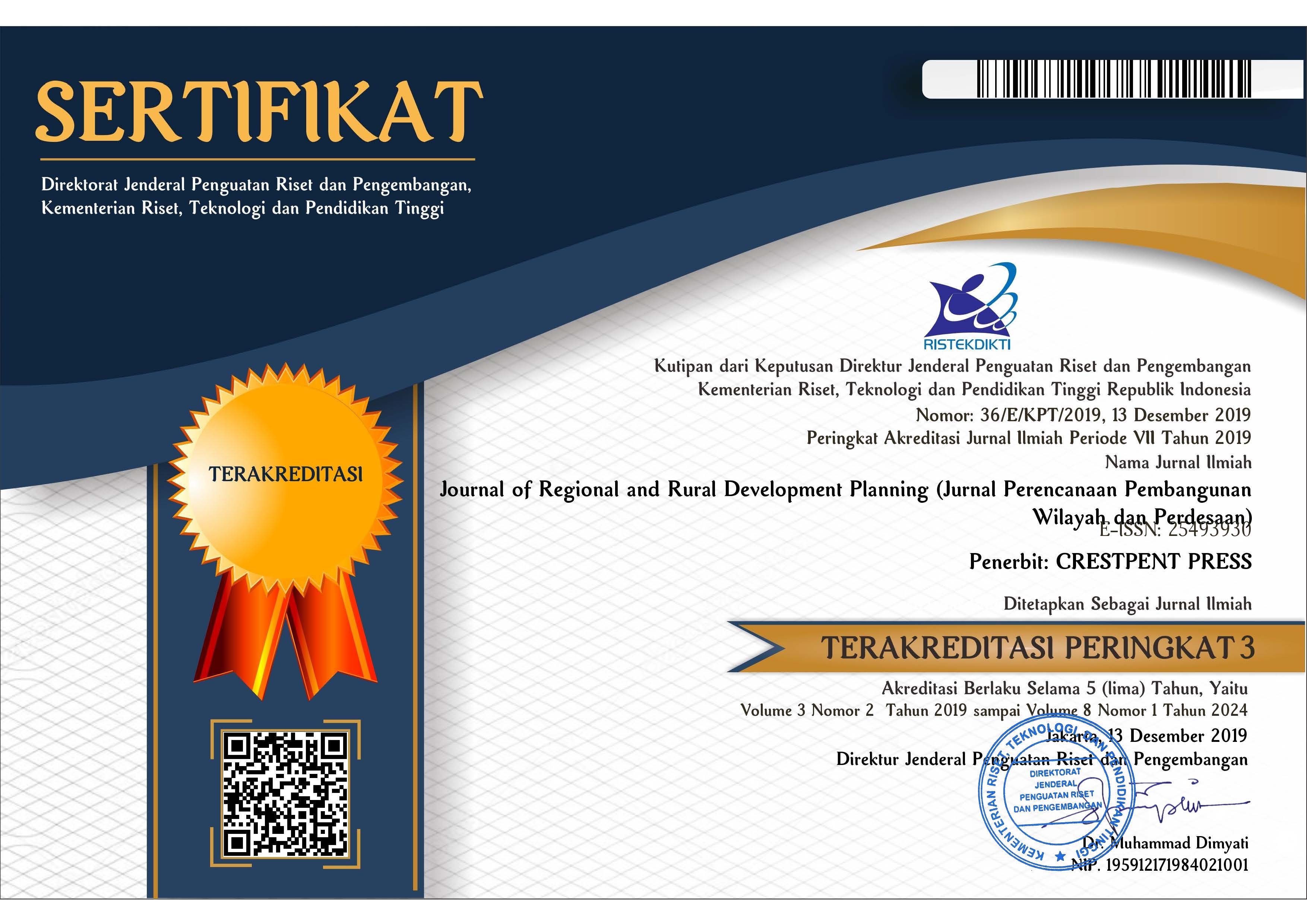Keterkaitan Belanja Pemerintah terhadap PDRB Perkapita Kabupaten/Kota di Sulawesi Tenggara
Abstract
The issuance of Law No. 1 of 2022 as a complement to Law No. 23 of 2004 concerning financial relations between the central and regional governments. Fiscal transfer policies are becoming more selective in seeing local needs. However, this needs to be supported by good fiscal management in the regions to carry out development activities that have an impact on increasing income that is more evenly distributed between regions and communities. One of the important instruments of fiscal decentralization is the management of government spending. Therefore, the purpose of this study is to examine the relationship between government spending and per capita income in Southeast Sulawesi. The units of observation analyzed are gross regional domestic product per capita in the previous year, personnel expenditures, goods and services expenditures, capital expenditures, HDI, district and city dummy variables. The model approach in the calculation is panel data regression analysis from 2016-2020. Based on the test results, the probability (F-statistics) is obtained, the equation of income per capita the Hausman test > 0.05, then the random effect model (REM) equation is the best model choice. The results of the analysis show all independent variables have a strong relationship with the dependent variable in the model which is shown by an R-square of 0.982. Variables that show significant effect on the increase in percapita income are (𝐺𝑅𝐷𝑃𝑝𝑟𝑘(𝑡−1)), goods and services expenditure, capital expenditure and HDI, while personnel expenditure has a negative effect on per capita income for both districts and cities in Southeast Sulawesi Province.
References
Baltagi, B. H. (2005). Econometrics Analysis of Panel Data. England (GB): John Wiley and Sons.
[BPS] Badan Pusat Statistik. (2020). Statistik Daerah Sulawesi Tenggara. Sulawesi Tenggara (ID): BPS Daerah Sulawesi Tenggara.
Deswantoro, D. B., Ismail, A., & Hendarmin, H. (2017). Pengaruh Belanja Daerah Berdasarkan Klasifikasi Ekonomi terhadap Pertumbuhan Ekonomi dan Kesejahteraan Masyarakat di Kabupaten/Kota Provinsi Kalimantan Barat Tahun 2010 - 2015. Jurnal Ekonomi Bisnis Dan Kewirausahaan, 6(3), 187.
Dudzevičiūtė, G., Šimelytė, A., & Antanavičienė, J. (2017). Causal nexus between export and economic growth in the European Union countries. Montenegrin Journal of Economics, 13(2), 107–120.
Expenditure, C., & Growth, E. (2020). The Impact of Economic Growth and Human Development Index on Poverty in Riau Province. Journal of Economics and Sustainable Development, 2(02).
Ezkirianto, R., & Alexandi, M. F. (2018). Analisis Keterkaitan Antara Indeks Pembangunan Manusia Dan Pdrb Per Kapita Di Indonesia. Jurnal Ekonomi Dan Kebijakan Pembangunan, 2(1), 14–29.
Faridi, M. Z. (2011). Contribution of Fiscal Decentralization to Economic Growth : Evidence from Pakistan. 31(1), 1–13.
Feng, H., Liu, Z., Wu, J., Iqbal, W., Ahmad, W., & Marie, M. (2022). Nexus between Government spending’s and Green Economic performance: Role of green finance and structure effect. Environmental Technology & Innovation, 27, 102461. https://doi.org/10.1016/j.eti.2022.102461
Hajamini, M., & Falahi, M. A. (2014). The nonlinear impact of government consumption expenditure on economic growth: Evidence from low and low-middle income countries. Cogent Economics and Finance, 2(1).
Haryanto JT. (2016). Kebijakan Strategis Transfer ke Daerah dan Dana Desa 2016 [Internet]. [diunduh 2017 Maret 25]. Tersedia pada http://www.kemenkeu.go.id/media4420/kebijakan-strategis-tkd-dan-dd-2016.pdf
Hidayat, I., Mulatsih, S., & Rindayati, W. (2020). The Determinants of Inclusive Economic Growth in Yogyakarta. Jurnal Economia, 16(2), 200–210.
Iskandar, I. (2017). Effect Of Human Development Index Fund on Economic Growth Through A Special Autonomy. Jurnal Ekonomi Pembangunan: Kajian Masalah Ekonomi Dan Pembangunan, 18(1), 50.
Juanda B, Suratman E, Handra H. (2017). The fiscal transfer effect on regional inequality. Seminar onThe 6thIRSA International Institute, Manado: IRSA Institute.
Juanda B. 2016. Reformasi Kebijakan Desentralisasi Fiskal Upaya Mendorong Pertumbuhan dan Mengurangi Kesenjangan Antardaerah. Radar Banten. Rubrik Opini: 2 (Kol 1-4),
Juanda, B., Heriwibowo, D. (2016). Konsolidasi Desentralisasi Fiskal Melalui Reformasi Kebijakan Belanja Daerah Berkualitas. Jurnal Ekonomi Kebijakan Publik, 7, No. 1 Juni 2016, Pusat Pengkajian Pengelolaan Data dan Informasi, DPR RI.
Juanda B, Junaidi. (2012). Ekonometrika Deret Waktu. Bogor: IPB Press
Juanda, B. (2019). Apbn berkualitas 1. 1–40.
Khan, Q., Faguet, J. P., & Ambel, A. (2017). Blending Top-Down Federalism with Bottom-Up Engagement to Reduce Inequality in Ethiopia. World Development, 96, 326–342.
Lewaherilla dan, E., & Hendra Tanate Fakultas Ekonomi dan Bisnis, D. (2020). Determinasi pendapatan perkapita sebagai Jalan keluar dari middle income trap. Esy Lewaherilla Dan Devrin Hendra Tanate, 3(1), 13–21.
Limoeiro, D. (2015). Beyond income transfers: The decline of regional inequality in Brazil during the 2000s. Progress in Development Studies, 15(1), 6–21.
Musgrave, R. (1959). The Theory of Public Finance.N.Y. McGraw-Hill
Napitupulu. (2017). UNIVERSITAS SUMATERA UTARA Poliklinik UNIVERSITAS SUMATERA UTARA. Jurnal Pembangunan Wilayah & Kota, 1(3), 82–91.
Nazara S. (2010). Pemerataan Antar Daerah Sebagai Tantangan Utama Transformasi Struktural Pembangunan Ekonomi Indonesia Masa Depan. Pidato Pengukuhan Guru Besar Tetap Bidang Ilmu Ekonomi. Universitas Indonesia.
Noviyanti, D. (2021). Determinan Pertumbuhan Ekonomi Wilayah Pengembangan Jawa Barat Tahun 2014-2018 dengan Pendekatan Regresi Panel Spasial. Seminar Nasional Official Statistics, 2021(1), 878–888.
Oates, W. E (1993). Fiscal Decentralization and Economic development. National Tax Journal, 26 (2): 237-243.
Todaro MP, Smith SC. (2012). Economic Development. Edisi II. Boston (UK): Pearson Education Inc
[UU] Undang-undang Nomor 33 Tahun 2004 tentang Perimbangan Keuangan antara Keuangan Pusat dan Keuangan Daerah. 2004
[UU] Undang-undang Nomor 1 Tahun 2022 tentang Hubungan Keuangan antara Keuangan Pusat dan Keuangan Daerah. 2022
[UU] Undang-undang Nomor 23 Tahun 2014 Tentang Pemerintah Daerah.
Wahyuni, S., Juanda, B., & Fahmi, I. (2018). Kualitas Belanja Daerah Dan Hubungannya Dengan Kinerja Pembangunan Di Provinsi Banten. Jurnal Ekonomi Dan Kebijakan Pembangunan, 6(2), 16–31.
Wallich, C., & Bird, R. (1993). Fiscal decentralization and intergovernmental relations in transition economics: toward a systematic framework of analysis. The World Bank, Policy Research Working Paper Series: 1122, 1993.
Wardhana, A., Juanda, B., Siregar, H., & Wibowo, K. (2013). Dampak Transfer Pemerintah Pusat Terhadap Penurunan Ketimpangan Pendapatan Di Indonesia. Sosiohumaniora, 15(2), 111.
Zhang, T., Zou, H. H. (2001) The Growth Impact of Intersectoral and Intergovernmental Allocation of Public Expenditure: with applications to China and India. China Economic Review, 2: 58-81.
Copyright (c) 2023 Journal of Regional and Rural Development Planning (Jurnal Perencanaan Pembangunan Wilayah dan Perdesaan)

This work is licensed under a Creative Commons Attribution-ShareAlike 4.0 International License.




.png)














